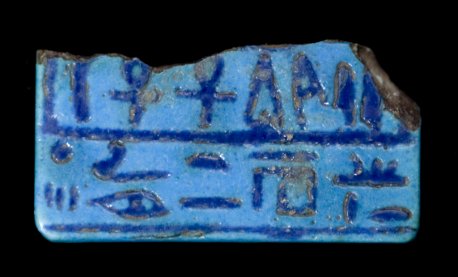Book Plate
Hieroglyphs
Book Plate [ edit ]
A complete example of a faience label currently in the British Museum provides an accurate reconstruction of the type of object to which this small fragment once belonged. Made of a bright blue faience, the sunk relief hieroglyphs are filled with a darker blue glaze, creating a harmonious contrast between background and text. The hieroglyphs on this fragment represent the end of three columns of text that once read (the preserved text on the Yale label are in bold): “Beloved of Ptah, king of the two lands; the good god, Neb-maat-re (Amunhotep III), given life; the king’s wife, Tiye, given life.” The bottom line of hieroglyphs reads “Book of the Sycamore Tree and of the Dom Palm,” the title of an otherwise unknown composition. The title may refer to a horticultural treatise, but a more likely reference is to a dialogue between two trees, such as that included within the corpus of New Kingdom love poetry.
The precise function of this object remains uncertain. The hieroglyphic text on both “book-plates” suggests that the small faience tag served as the label of a papyrus scroll. Since the fully-preserved example in the British Museum does not have a hole or means of affixing the label directly to a scroll, the rectangular faience label might have been affixed to separate compartments within a box designed to house papyri (Parkinson, in Davies, ed., Studies in Egyptian Antiquities, pp. 52-53). The names of Amunhotep III and his chief queen Tiye on the faience plaques suggest that the “book plates” were once part of a royal library.
Period
Reign of Amenhotep III
Dimensions
H. 2.1 cm; W.3.8 cm
Material
Faience
Museum
Yale Art Gallery
Accession Number
1936.1
A. P. Kozloff, “The Malqata/El-Amarna Blues: Favourite Colours of Kings and Gods,” in E. Goring, N. Reeves, and J. Ruffle, eds., Chief of Seers: Egyptian Studies in Memory of Cyril Aldred (London, 1997), pp. 180-186.
Richard Parkinson, “Two or Three Literary Artefacts,” in W.V. Davies, ed., Studies in Egyptian Antiquities: A Tribute to T.G.H. James (London: British Museum, 1999), pp. 49-57.
G. D. Scott, Ancient Egyptian Art at Yale (New Haven, 1986), p. 99.
For another example from this corpus, compare the small plaque with the name and royal titles of Amunhotep III without book name made of white faience with blue hieroglyphs in F. D. Friedman, ed., Gifts of the Nile, Ancient Egyptian Faience (London, 1998), p. 184, no. 24 (Musée du Louvre E 3043).
